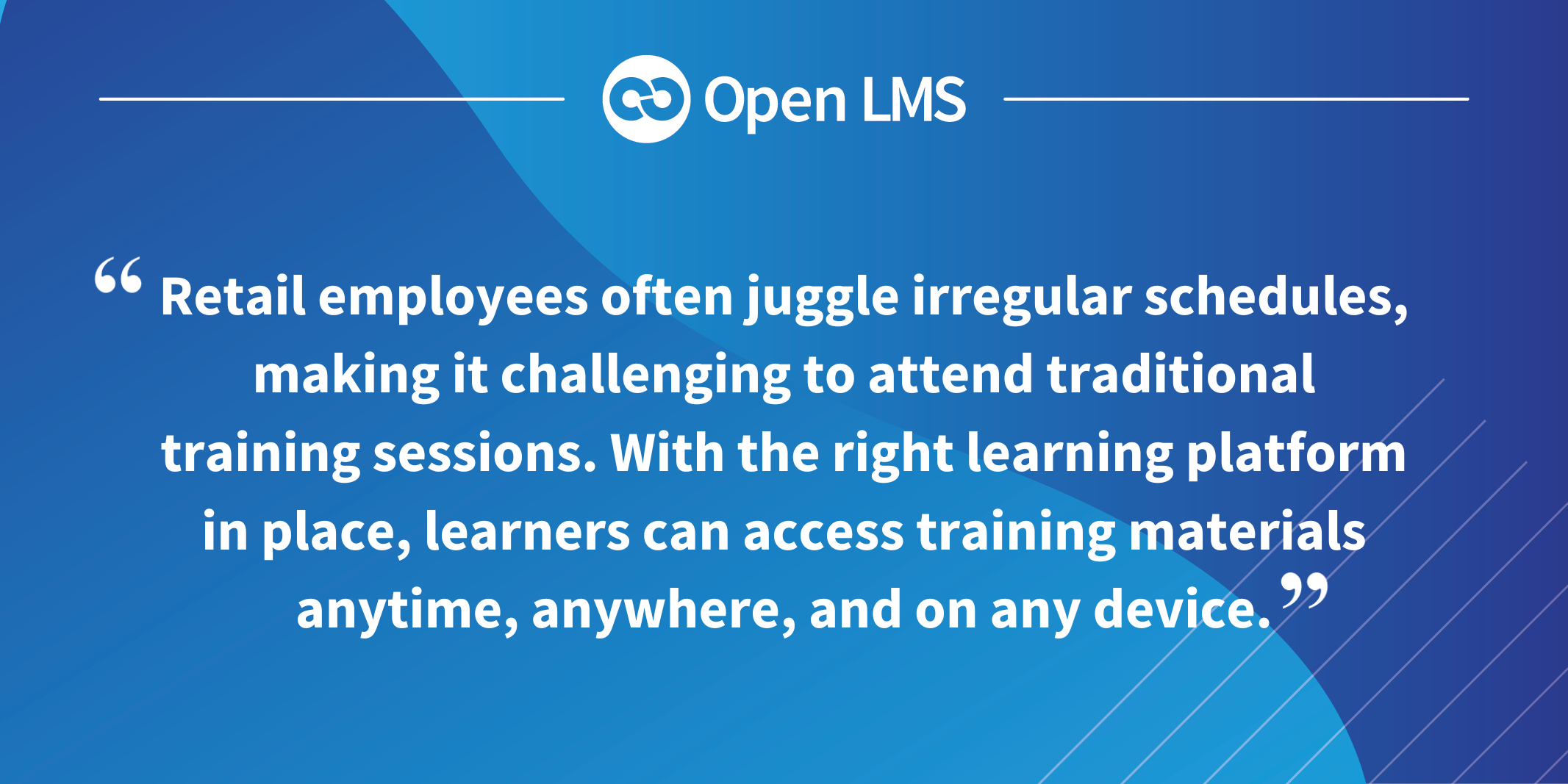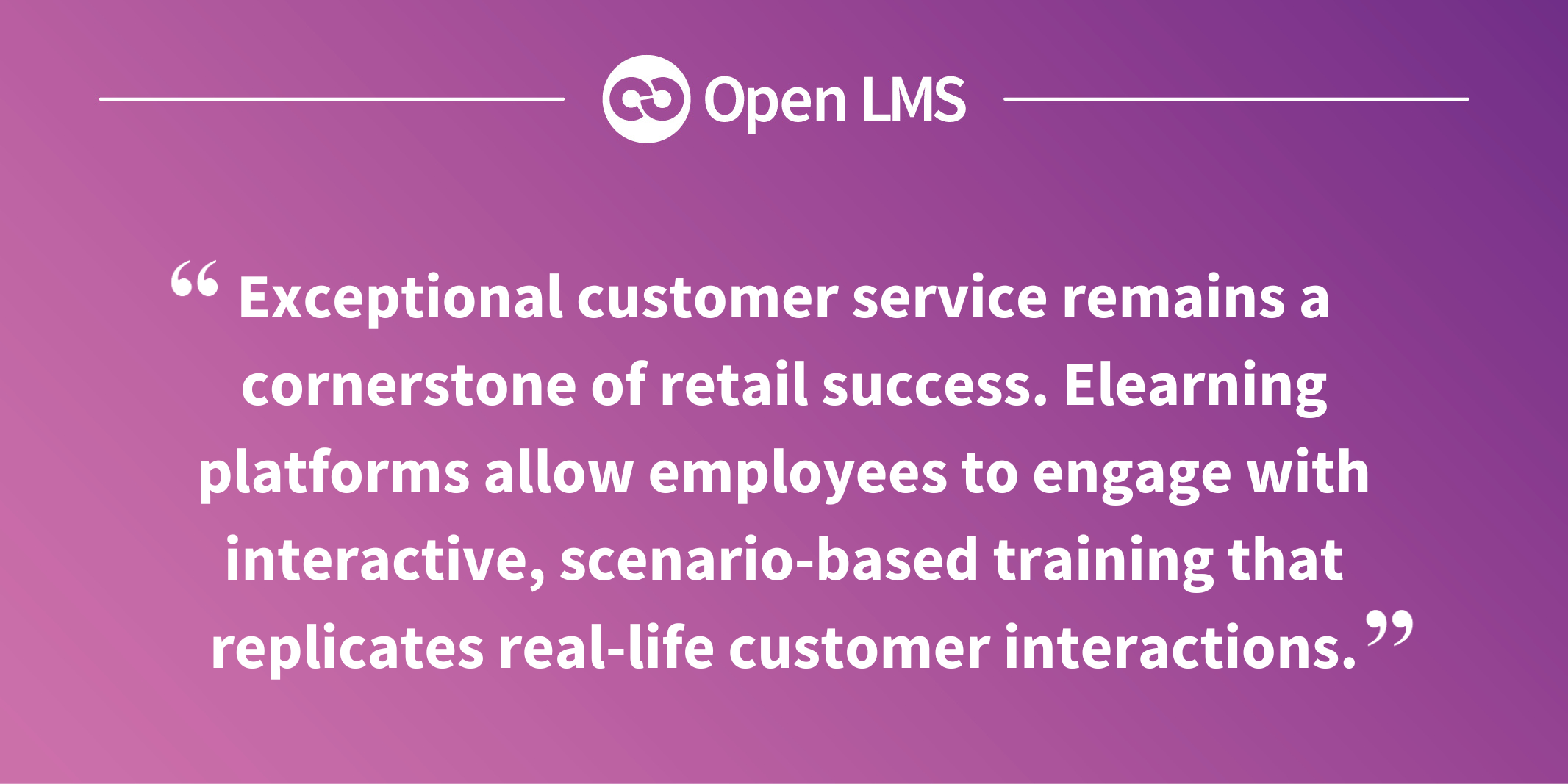9 Ways Elearning Can Benefit Retail Organizations
Editor’s Note: This article has been refreshed with up-to-date information to ensure accuracy and relevance.
The retail business landscape is more complex than ever, shaped by rapid technological advancements and the ever-growing demands of well-informed customers. These shifts have fundamentally altered how businesses approach sales and customer engagement. For sales teams to thrive, they require more than just surface-level training: they need a robust eLearning framework and a reliable learning platform.
How can virtual training equip sales teams to excel in this new reality? Let’s dive in and find out.
The Changing Dynamics of Retail Sales
Picture this: Tim is in the market for a new couch. He and his wife drive to the nearest furniture store, where they engage with a salesperson who walks them through options within their budget. They shortlist a couple of choices and negotiate for the best deal. After being offered a 10% discount and assured of the product’s quality and warranty, they leave feeling confident they’ve secured a great purchase.
While this scenario might have been typical in the 90s, does it still align with today’s buying habits?
The simple answer is no. The dynamics of shopping and selling have shifted significantly. Many leading retail brands don’t even operate physical stores. Customers have become incredibly informed, with instant access to reviews, price comparisons, and competitor offerings right at their fingertips. This makes it increasingly difficult for sales professionals to shape customer perceptions or control the narrative around quality and value.
Despite these challenges, the salesperson's role remains vital. Product knowledge is still a cornerstone of building trust and credibility with customers, especially when customers come armed with extensive research.
YOU MIGHT ALSO LIKE | ‘3 Common Franchise Training Challenges (And How an LMS Can Help)’

9 Ways That Virtual Training Addresses Retail’s Biggest Challenges
Retailers face many challenges, from meeting the expectations of informed customers to managing high employee turnover. Elearning offers an innovative solution that combines flexibility and scalability to tackle these hurdles head-on. Here’s how:
1) Enhancing Product Launch Readiness
Retail businesses frequently introduce new products or update existing offerings. Elearning enables quick dissemination of product information through engaging content formats like video tutorials, interactive demos, and quizzes. This approach can not only be used to ensure that all team members are well-versed in product features and benefits before launch—it can also be used to directly inform and educate customers about product USPs through a customer education program.
By complementing staff readiness with customer understanding, businesses can hit the ground running with confident, knowledgeable teams and informed buyers.
2) Scaling Training for Seasonal Staff
The retail industry often experiences fluctuations in staffing needs, especially during peak seasons. Elearning provides a scalable solution to onboard and train seasonal employees efficiently. Pre-built training modules, accessible on demand, ensure that temporary staff can quickly get up to speed without draining resources or compromising on quality of understanding.
3) Supporting Flexible Learning
Retail employees often juggle irregular schedules, making it challenging to attend traditional training sessions. With the right learning platform in place, learners can access training materials anytime, anywhere, and on any device. This ensures that staff can complete training at their own pace without disrupting daily operations.
READ MORE ON THE POWER OF ON-THE-GO LEARNING | ‘How to Support On-the-Go Elearning With a Strong LMS Mobile App’
4) Decreasing Turnover Rates
Elearning platforms can offer pathways for continuous professional development, helping retail employees gain skills beyond their immediate roles. This not only boosts morale but also reduces turnover, as employees see opportunities for growth within the organization. According to a 2024 survey, 48% of American workers say they would switch to a new job if it offered skills training opportunities. Offering advanced sales courses or industry-specific certifications can create a motivated and engaged retail workforce.
5) Providing Consistent, Up-to-Date Training
In retail, promotions, store policies, and customer expectations can suddenly shift. With eLearning, training content can be updated and disseminated rapidly across a distributed workforce. Whether seasonal staff or full-time employees, everyone gains access to the latest knowledge, ensuring they’re prepared to inform and assist customers effectively.
Elearning also equips sales teams with updates based on overlooked insights. For instance, when feedback uncovers an under-emphasized product benefit, updated training ensures staff can confidently highlight this detail in sales conversations. By swiftly incorporating this information, retailers can better engage customers and guide them toward making final purchasing decisions.
HANDPICKED FOR YOU | ‘Top L&D Trends for 2025: Embracing AI, Skills-Based Hiring, and Immersive Tech’

6) Reducing Training Costs
Traditional classroom-based training methods often involve significant costs, from hiring instructors to travel and venue expenses. Elearning eliminates many of these overheads by enabling self-paced, remote learning. Training modules can be reused and scaled for new hires without requiring additional resources, making it an ideal choice for industries with retail which have high turnover rates.
7) Developing Strong Customer Support
Exceptional customer service remains a cornerstone of retail success. Learning platforms allow employees to engage with interactive, scenario-based training that replicates real-life customer interactions. For instance, video simulations and gamified modules can teach sales reps effective communication techniques, from handling objections to highlighting product benefits. These tools empower employees to build stronger customer relationships and boost satisfaction.
HANDPICKED FOR YOU | ‘Gamification in Education: How to Use It (With Examples)’
8) Leveraging Data Analytics for Smarter Training
Modern retail thrives on data insights, from tracking customer preferences to analyzing purchasing behaviors. While LMSs themselves don't directly transform this data into training content, integrating them with external analytics tools or CRM systems can centralize valuable information.
By housing these insights within the LMS, instructional designers gain easier access to customer data, streamlining the creation of targeted training modules. For instance, trends in customer inquiries or purchasing habits can inspire eLearning content that equips sales teams to address frequent questions, highlight trending product features, or connect more effectively with specific customer personas.
Furthermore, these insights could be leveraged to create customer-facing educational content, such as FAQs or video tutorials, addressing specific questions or concerns and enhancing the overall customer experience. This integration saves time, eliminates unnecessary back-and-forth between platforms, and ensures training aligns closely with real-world customer expectations.
9) Supporting Multi-Lingual Training Needs
For global or diverse retail teams, learning platforms can provide content in multiple languages. This ensures that all employees, regardless of location or language proficiency, receive consistent, high-quality training. Multilingual support fosters inclusivity and improves communication across teams, enhancing overall efficiency.
MORE ON CORPORATE TRAINING | ‘The Key to L&D Success: Budgeting for an LMS That Delivers ROI’
Build Your Ideal Retail Training Environment
In summary, when your training strategy hits the mark, your teams achieve:
- Greater success in closing deals
- More innovative solutions for customer challenges
- Meaningful, trust-building customer interactions
- The ability to confidently challenge preconceptions with authority
- Stronger, long-term customer loyalty
- Reduced staff turnover
Whether you’re training employees or customers, it’s important to make sure your approach to content delivery is effective and interactive. In retail organizations, eLearning facilitated by an LMS is the answer!
Ready to transform your retail training strategy? Discover how Open LMS has helped retailers like Sodimac and OXXO empower their teams to excel in a highly competitive market. Contact us today to learn more or request a demo.